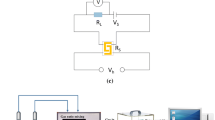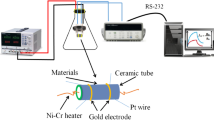Abstract
Metal oxides have been widely used in gas sensors. Metal oxides have the advantages of low cost, easy preparation and stable performance. However, the disadvantage of their high operating temperature limits their wider application. In this paper, a simple method based on hydrothermal reaction was developed to prepare ZnO/In2O3 composites with high response values capable of fast recovery. The chemical composition, microscopic morphology and structure of the ZnO/In2O3 composites were investigated by various characterization methods to determine the formation of ZnO/In2O3 heterojunction. The gas-sensitive properties of pure In2O3 and ZnO/In2O3 composites were tested at room temperature. The results showed that ZnO/In2O3 composites with different Zn/In molar ratios had short recovery time and high response value to NO2 at room temperature. Among them, the ZnO/In2O3 with Zn/In molar ratio of 2:1 showed the best gas-sensitive performance to NO2 at room temperature. The response values to NO2 were measured at concentrations of 5, 10, 20, and 30 ppm, resulting in values of 2.70, 3.26, 4.80, and 5.25, respectively. The response time to NO2 at 30 ppm was 267 s, with a recovery time of 7 s. In addition, ZnO/In2O3 composites have good long-term stability and selectivity to NO2 at room temperature.













Similar content being viewed by others
Explore related subjects
Discover the latest articles, news and stories from top researchers in related subjects.Data availability
All data generated or analyzed during this study are included in this published article.
References
M. Guarnieri, J.R. Balmes, Outdoor air pollution and asthma. Lancet 383, 1581–1592 (2014). https://doi.org/10.1016/S0140-6736(14)60617-6
P. Singla, S. Singhal, N. Goel, Theoretical study on adsorption and dissociation of NO2 molecules on BNNT surface. Appl. Surf. Sci. 283, 881–887 (2013). https://doi.org/10.1016/j.apsusc.2013.07.038
T. Pham, G. Li, E. Bekyarova, M.E. Itkis, A. Mulchandani, MoS2-based optoelectronic gas sensor with sub-parts-per-billion limit of NO2 gas detection. ACS Nano 13(3), 3196–3205 (2019). https://doi.org/10.1021/acsnano.8b08778
J. Jaiswal, A. Sanger, P. Tiwari, R. Chandra, MoS2 hybrid heterostructure thin film decorated with CdTe quantum dots for room temperature NO2 gas sensor. Sensor Actuat. B-Chem. 305, 127437 (2020). https://doi.org/10.1016/j.snb.2019.127437
D.J. Buckley, N.C.G. Black, E.G. Castanon, C. Melios, M. Hardman, O. Kazakova, Frontiers of graphene and 2D material-based gas sensors for environmental monitoring. 2D Mater. 7(3), 032002 (2020). https://doi.org/10.1088/2053-1583/ab7bc5
M. Chen, Z.H. Wang, D.M. Han, F.B. Gu, G.S. Guo, Porous ZnO polygonal nanoflakes: synthesis, use in high-sensitivity NO2 gas sensor, and proposed mechanism of gas sensing. J. Phys. Chem. C 115(26), 12763–12773 (2011). https://doi.org/10.1021/jp201816d
Y.S. Kang, S. Pyo, E. Jo, J. Kim, Light-assisted recovery of reacted MoS2 for reversible NO2 sensing at room temperature. Nanotechnology 30, 355504 (2019). https://doi.org/10.1088/1361-6528/ab2277
A.V. Agrawal, R. Kumar, S. Venkatesan, A. Zakhidov, G. Yang, J. Bao, M. Kumar, M. Kumar, Photoactivated mixed in-plane and edge-enriched p-type MoS2 flake-based NO2 sensor working at room temperature. ACS Sens. 3(5), 998–1004 (2018). https://doi.org/10.1021/acssensors.8b00146
R. Kumar, O. Al-Dossary, G. Kumar, A. Umar, Zinc oxide nanostructures for NO2 gas–sensor applications: a review. Nano-Micro Lett. 7, 97–120 (2015). https://doi.org/10.1007/s40820-014-0023-3
A. Nandan, P. Mondal, S. Kumar, N.A. Siddiqui, S. Sinha, S. Subramani, A.K. Singh, S. Raja, C.M. Hussain, Investigation of indoor air pollutants in different environmental settings and their health impact: a case study of Dehradun, India. Air Qual. Atmos. Heal. 16, 2377–2400 (2023). https://doi.org/10.1007/s11869-023-01411-3
D.J. Late, Y.K. Huang, B. Liu, J. Acharya, S.N. Shirodkar, J.J. Luo, A.M. Yan, D. Charles, U.V. Waghmare, V.P. Dravid, C.N.R. Rao, Sensing behavior of atomically thin-layered MoS2 transistors. ACS Nano 7(6), 4879–4891 (2013). https://doi.org/10.1021/nn400026u
K. Luo, R.K. Li, W.J. Li, Z.S. Wang, X.M. Ma, R.M. Zhang, X. Fang, Z.L. Wu, Y. Cao, Q. Xu, Acute effects of nitrogen dioxide on cardiovascular mortality in Beijing: an exploration of spatial heterogeneity and the districtspecifc predictors. Sci. Rep. 6(1), 38328 (2016). https://doi.org/10.1038/srep38328
Y. Shen, H. Bi, T. Li, X. Zhong, X. Chen, A. Fan, D. Wei, Low-temperature and highly enhanced NO2 sensing performance of Au-functionalized WO3 microspheres with a hierarchical nanostructure. Appl. Surf. Sci. 434, 922–931 (2018). https://doi.org/10.1016/j.apsusc.2017.11.046
K. Malook, H. Khan, M. Ali, I.U. Haque, Investigation of room temperature humidity sensing performance of mesoporous CuO particles. Mat. Sci. Semicon. Proc. 113, 105021 (2020). https://doi.org/10.1016/j.mssp.2020.105021
Z. Li, Y. Zhang, H. Zhang, Y. Jiang, J. Yi, Superior NO2 sensing of MOF-derived indium-doped ZnO porous hollow cages. ACS Appl. Mater. Interfaces 12, 37489–37498 (2020). https://doi.org/10.1021/acsami.0c10420
S.P. Patil, V.L. Patil, S.S. Shendage, N.S. Harale, S.A. Vanalakar, J.H. Kim, P.S. Patil, Spray pyrolyzed indium oxide thick films as NO2 gas sensor. Ceram. Int. 42, 16160–16168 (2016). https://doi.org/10.1021/acsami.0c10420
Y. Zhong, W. Li, X. Zhao, X. Jiang, S. Lin, Z. Zhen, W. Chen, D. Xie, H. Zhu, High-response room-temperature NO2 sensor and ultrafast humidity sensor based on SnO2 with rich oxygen vacancy. ACS Appl. Mater. Interfaces 11(14), 13441–13449 (2019). https://doi.org/10.1021/acsami.9b01737
M. Arain, A. Nafady, S. Sirajuddin, Z. Ibupoto, S. Sherazi, T. Shaikh, H. Khan, A. Alsalme, A. Niaz, M. Willander, Simpler and highly sensitive enzyme-free sensing of urea via NiO nanostructures modified electrode. RCS Adv. 6, 39001–39006 (2016). https://doi.org/10.1039/C6RA00521G
H. Khan, K. Malook, M. Shah, Highly selective and sensitive ammonia sensor using polypyrrole/V2O5 composites. J. Mater. Sci. Mater. Electron. 28, 13873–13879 (2017). https://doi.org/10.1007/s10854-017-7235-5
S. Malik, A. Khan, G. Rahman, N. Ali, H. Khan, S. Khan, M.D.P.T. Sotomayor, Core-shell magnetic molecularly imprinted polymer for selective recognition and detection of sunset yellow in aqueous environment and real samples. Environ. Res. 212, 113209 (2022). https://doi.org/10.1016/j.envres.2022.113209
H. Khan, K. Malook, M. Shah, Synthesis, characterization, and electrical properties of polypyrrole–bimetallic oxide composites. J. Appl. Polym. 137(2), 47680 (2019). https://doi.org/10.1002/app.47680
K. Malook, H. Khan, M. Shan, I.U. Haque, Highly selective and sensitive response of Polypyrrole–MnO2 based composites towards ammonia gas. Polym. 4(40), 1676–1683 (2019). https://doi.org/10.1002/pc.24917
J. Zhang, H. Lu, C. Liu, C. Chen, X. Xin, Porous NiO–WO3 heterojunction nanofibers fabricated by electrospinning with enhanced gas sensing properties. RSC Adv. 7, 40499–40509 (2017). https://doi.org/10.1039/C7RA07663K
H. Xu, J. Zhang, A.U. Rehman, L. Gong, K. Kan, L. Li, K. Shi, Synthesis of NiO@CuO nanocomposite as high-performance gas sensing material for NO2 at room temperature. Appl. Surf. Sci. 412, 230–237 (2017). https://doi.org/10.1016/j.apsusc.2017.03.213
S. Bai, H. Fu, Y. Zhao, K. Tian, R. Luo, D. Li, A. Chen, On the construction of hollow nanofibers of ZnO-SnO2 heterojunctions to enhance the NO2 sensing properties. Sensor Actuat. B-Chem. 266, 692–702 (2018). https://doi.org/10.1016/j.snb.2018.03.055
E. Espid, F. Taghipour, Development of highly sensitive ZnO/In2O3 composite gas sensor activated by UV-LED. Sensor Actuat. B-Chem. 241, 828–839 (2017). https://doi.org/10.1016/j.snb.2016.10.129
P. Scherrer, Bestimmung der Grösse und der inneren Struktur von Kolloidteilchen mittels Röntgenstrahlen. Nachr. Ges. Wiss. Göttingen 26, 98 (1918). https://doi.org/10.1007/978-3-662-33915-2_7
K. Malook, H. Khan, M. Shah, I.U. Haque, Synthesis, characterization and electrical properties of polypyrrole/V2O5 composites. Korean J. Chem. Eng. 35, 12–19 (2018). https://doi.org/10.1007/s11814-017-0263-2
H. Khan, K. Malook, M. Shah, Polypyrrole/MnO2 composites: synthesis, structural and electrical properties. J. Mater. Sci. Mater. Electron. 29, 9090–9098 (2018). https://doi.org/10.1007/s10854-018-8936-0
J.I. Langford, A.J.C. Wilson, Scherrer after sixty years: a survey and some new results in the determination of crystallite size. J. Appl. Cryst. 11, 102 (1978). https://doi.org/10.1107/S0021889878012844
C. Li, Z. Du, H. Yu, T. Wang, Low-temperature sensing and high sensitivity of ZnO nanoneedles due to small size effect. Thin Solid Films 517(20), 5931–5934 (2009). https://doi.org/10.1016/j.tsf.2009.04.025
L. Shi, J. Cui, F. Zhao, D. Wang, T. Xie, Y. Lin, High-performance formaldehyde gas-sensors based on three dimensional center-hollow ZnO. Phys. Chem. Chem. Phys. 17, 31316–31323 (2015). https://doi.org/10.1039/C5CP05935F
K. Jiang, Y. Weng, S. Guo, Y. Yu, F. Xiao, Self-assembly of metal/semiconductor heterostructures via ligand engineering: unravelling the synergistic dual roles of metal nanocrystals toward plasmonic photoredox catalysis. Nanoscale 9, 16922–16936 (2017). https://doi.org/10.1039/C7NR04802E
K. Zhang, S. Qin, P. Tang, Y. Feng, D. Li, Ultra-sensitive ethanol gas sensors based on nanosheet-assembled hierarchical ZnO-In2O3 heterostructures. J. Hazard. Mater. 391, 122191 (2020). https://doi.org/10.1016/j.jhazmat.2020.122191
X. Zhang, B. Dong, W. Liu, X. Zhou, M. Liu, X. Sun, J. Lv, L. Zhang, W. Xu, X. Bai, L. Xu, S. Mintova, H. Song, Highly sensitive and selective acetone sensor based on three-dimensional ordered WO3/Au nanocomposite with enhanced performance. Sensor Actuat. B-Chem. 230, 128405 (2020). https://doi.org/10.1016/j.snb.2020.128405
B. Nam, T.K. Ko, S.K. Hyun, C. Lee, NO2 sensing properties of WO3-decorated In2O3 nanorods and In2O3-decorated WO3 nanorods. Nano Converg. 6, 40 (2019). https://doi.org/10.1186/s40580-019-0205-2
M. Bai, M. Chen, X. Li, Q. Wang, One-step CVD growth of ZnO nanorod/SnO2 film heterojunction for NO2 gas sensor. Sensor Actuat. B-Chem. 373, 132738 (2022). https://doi.org/10.1016/j.snb.2022.132738
S. Cui, Z. Wen, X. Huang, J. Chang, J. Chen, Stabilizing MoS2 nanosheets through SnO2 nanocrystal decoration for high-performance gas sensing in air. Small 11, 2305–2313 (2015). https://doi.org/10.1002/smll.201402923
Z. Li, C. Lou, G. Lei, G. Lu, H. Pan, X. Liu, J. Zhang, Regulation of electronic properties of ZnO/In2O3 heterospheres via atomic layer deposition for high performance NO2 detection. CrystEngComm 29, 5060–5069 (2021). https://doi.org/10.1039/D1CE00643F
F. Gu, R. Nie, D. Han, Z. Wang, In2O3-graphene nanocomposite based gas sensor for selective detection of NO2 at room temperature. Sensor Actuat. B-Chem. 219, 94–99 (2015). https://doi.org/10.1016/j.snb.2015.04.119
D. Sun, Y. Luo, M. Debliquy, C. Zhang, Graphene-enhanced metal oxide gas sensors at room temperature: a review. Beilstein J. Nanotechnol. 9, 2832–2844 (2018). https://doi.org/10.3762/bjnano.9.264
J. Wang, Y. Shen, X. Li, Y. Xia, C. Yang, Synergistic effects of UV activation and surface oxygen vacancies on the room-temperature NO2 gas sensing performance of ZnO nanowires. Sensor Actuat. B-Chem. 298, 126858 (2019). https://doi.org/10.1016/j.snb.2019.126858
S. Bai, T. Guo, Y. Zhao, J. Sun, D. Li, A. Chen, C. Liu, Sensing performance and mechanism of Fe-doped ZnO microflowers. Sensor Actuat. B-Chem. 195, 657–666 (2014). https://doi.org/10.1016/j.snb.2014.01.083
X. Liang, J. Zhang, L. Du, M. Zhang, Effect of resonant tunneling modulation on ZnO/In2O3 heterojunction nanocomposite in efficient detection of NO2 gas at room temperature. Sensor Actuat. B-Chem. 329, 129230 (2021). https://doi.org/10.1016/j.snb.2020.129230
L. Ma, H. Fan, H. Tian, J. Fang, X. Qian, The n-ZnO/n-In2O3 heterojunction formed by a surface-modification and their potential barrier-control in methanal gas sensing. Sensor Actuat. B-Chem. 222, 508–516 (2016). https://doi.org/10.1016/j.snb.2015.08.085
Funding
This research was supported by the Independent Innovation Fund of the Second Research Institute of China Aerospace Science and Industry Corporation (110000856); the Fundamental Research Funds for the Central Universities (2023ZKPYTD01).
Author information
Authors and Affiliations
Contributions
XH contributed to the experiments and data analysis supervision, funding acquisition, reviewing and editing of the manuscript. YL contributed to the conceptualization of the study, experiments, data analysis, and manuscript editing. BP, YL and JP contributed to the experimental resources. GW, SM and ML contributed to the experiments.
Corresponding author
Ethics declarations
Competing interests
The authors declare that they have no any competing financial interest or personal relationship that affects this work.
Ethical approval
This work did not require any ethical approval.
Consent for publication
All authors declare their consent for publication of the manuscript.
Research involving human and animal participants
No human and/or animal studies have been executed.
Additional information
Publisher's Note
Springer Nature remains neutral with regard to jurisdictional claims in published maps and institutional affiliations.
Rights and permissions
Springer Nature or its licensor (e.g. a society or other partner) holds exclusive rights to this article under a publishing agreement with the author(s) or other rightsholder(s); author self-archiving of the accepted manuscript version of this article is solely governed by the terms of such publishing agreement and applicable law.
About this article
Cite this article
Huang, X., Li, Y., Liu, Y. et al. Room temperature NO2 sensor with rapid recovery based on ZnO/In2O3 heterojunction. J Mater Sci: Mater Electron 35, 869 (2024). https://doi.org/10.1007/s10854-024-12649-7
Received:
Accepted:
Published:
DOI: https://doi.org/10.1007/s10854-024-12649-7




